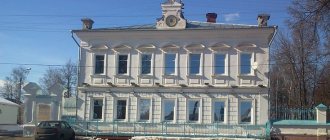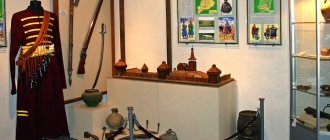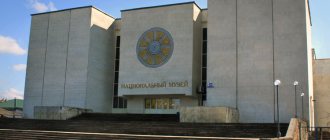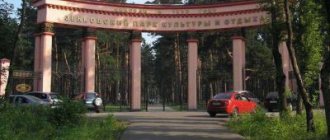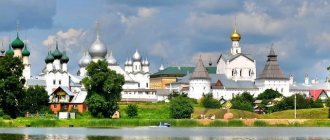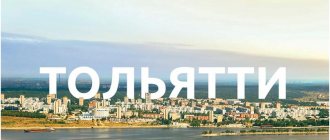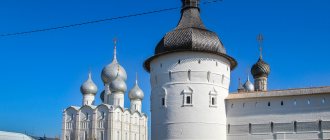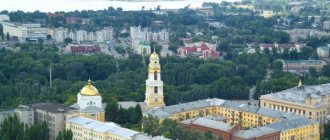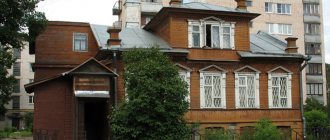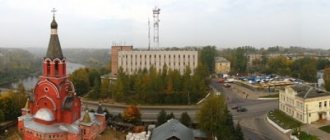RIA Voronezh continues its weekly special project “Weekend,” in which journalists and experts offer readers options for a non-trivial weekend getaway. The topic of the tenth issue is a trip to Ostrogozhsk, which celebrated 365 years since its founding on August 26, 2022.
Photo – Irina Ivanova
Ostrogozhsk, located on the banks of the Quiet Sosna River, was a military fortress and a county town. To this day, ancient merchant and bourgeois mansions and the layout of blocks and streets of the 18th century have been preserved here.
House-Museum of I.N. Kramskoy
One of the organizers of the famous Itinerants movement, Ivan Kramskoy, was born and lived in this city for almost 20 years. But he gained fame as an outstanding artist only after moving to St. Petersburg.
Art connoisseurs have a unique opportunity to see with their own eyes the house in which the early years of the life of this great master of painting of various genres passed. From the photographs on the walls you can get an idea of the life history of I.N. Kramskoy. The interior features furniture and other household items typical of those times. A monument to this artist was erected next to the house-museum.
Location: Marshak street - 14.
The house where G.N. lived Troepolsky
The author of the story “White Bim Black Ear” lived on Lenin Street for seventeen years from 1937. In Ostrogozhsk, he was the director of a site involved in the development of new grain crops.
The city has preserved many houses of merchants and politicians in their original architecture. Some buildings were destroyed during the war, but rebuilt. Ostrogozhsk is ideal for connoisseurs of art and literature. Famous artists, writers and poets lived and worked here.
In addition, in the Ostrogozhsky region there are many natural monuments, the beauty of which every self-respecting tourist should see and appreciate: chalk slopes on the right bank of the Don, the Mostishche farm with an ancient sanctuary discovered by archaeologists and other memorable places.
Ostrogozhsky Historical and Art Museum named after I.N. Kramskoy
It should immediately be noted that this building is equipped with all the necessary equipment to create a barrier-free environment. Not only wheelchair users, but also visually impaired and hearing impaired people can learn more about the history and culture of the city.
The museum houses a variety of thematic exhibitions. They introduce tourists not only to the peculiarities of life of landowners and other residents of the city, interesting archaeological finds and the history of the place, but also to the work of talented artists of this region.
A regular tour of the museum ends with a climb to the tower with the aim of viewing the whole of Ostrogozhsk from a bird's eye view. It should be noted that the guide will only work with a group of 10 people or more. You can also book a sightseeing tour of the city’s memorable places.
The museum is open to the public on all days except Monday and Tuesday. Prices for services are quite low.
Location: Kramskoy street - 4.
History of Ostrogozhsk
During its history, Ostrogozhsk had two names. The first one, which has survived to this day, came, according to various opinions, from the name of the Ostrogoshchi river or from the word “ostrozhek”, which meant fortification. The second name - Rybnoe - was due to the fact that there was an active trade in fish, which was transported along the Tikhaya Sosna River from the Don.
The need for a fortification structure on the Belgorod Line arose among Russian rulers in the first quarter of the 17th century, during its construction. The future fortress, which was supposed to protect the southern borders of the state from attacks by the Crimean Tatars and other enemies, appeared on the Tikhaya Sosna River in 1652. At the same time, the Trinity Church was built here, and a few years later - the Pyatnitsky nunnery, which existed until the end of the 18th century.
A significant meeting took place in Ostrogozhsk, described in many history textbooks.
On Maidan, Ostrogozhsk Square, in September 1696, Emperor Peter I received Hetman of Ukraine Mazepa and presented him with a fur coat from his own shoulder - for his good service and protection of Little Russia from Tatar raids.
In 1708, during the Northern War, Mazepa committed betrayal, went over to the side of the Swedes and immediately turned into an anti-hero. But the residents of Ostrogozh still decided to perpetuate the meeting between the hetman and the tsar, and in the 1990s they placed a memorial stone on the Maidan.
In subsequent years, Ostrogozhsk turned from a mostly military town into a trading town and quickly became one of the richest in the province. Numerous fairs were held here, various shops and stores were opened, which simultaneously contributed to the emergence of rich merchant houses and estates. Many of them have survived to this day and are architectural landmarks not only of Ostrogozhsk itself, but of the entire region in general.
Temple of the Archangel Michael on the Sands
This is one of the ancient churches in Ostrogozhsk, built in 1775. It attracts pilgrims with rare icons with pieces of the relics of saints (John the Baptist, St. Andrew the First-Called, St. George the Victorious and others). Among the rare shrines here is the icon of the Mother of God “Spreader of Bread,” which is considered miraculous. Believers also have a unique opportunity to see the ark with the relics of the “Bethlehem Babies” within the walls of the temple.
Nearby is the holy spring “Life-Giving Vine,” which owes its preservation to the icon of the Savior, accidentally found nearby. A religious procession from the Church of the Archangel Michael is regularly held here.
Location: Peschanaya street - 10.
Ostrogozhsk is a historical city of Russia and a settlement of military valor in the Voronezh region
Administration of the Ostrogozhsky municipal district Address: 397855, Ostrogozhsk, Lenin street, 22 Telephone: (47375) 4-22-80 Email Website: https://www.ostrogadm.ru/
Located 110 kilometers south of Voronezh and being the administrative center of the municipal district of the same name in the Voronezh region, the city of Ostrogozhsk is among 7 cities of the Voronezh region (Bobrov, Boguchar, Borisoglebsk, Voronezh, Novokhopersk, Ostrogozhsk, Pavlovsk) was included in the list of historical settlements in Russia in 1990 , approved by resolutions of the board of the Ministry of Culture of the RSFSR, the board of the State Construction Committee of the RSFSR and the presidium of the Central Council of VOOPIiK.
However, in July 2010, by a joint order of the Ministry of Culture of the Russian Federation and the Ministry of Regional Development of the Russian Federation, that list was reduced by more than 11 times - from 478 to 41. Moreover, officials who manage the culture and development of Russian regions, according to their own concepts, from the federal list along with all 7 Voronezh historical cities erased such historically significant settlements as Veliky Novgorod, Pereslavl-Zalessky, Pskov, Uglich and even Moscow.
The earth, as you know, begins from the Kremlin... (V. Mayakovsky)
At the same time, as you understand, all these cities have not become any less significant and continue to remain large and small historical centers of Russia in the eyes of Russians. Therefore, leaving behind the officials the right to decide on paper the issues of whether a particular settlement belongs to the historical values of Russia, let’s turn to real life in which Ostrogozhsk was, is and will remain, albeit small, but certainly a historical city of our region and our country.
The territory of the modern Ostrogozhsky district became part of Russia at the end of the 16th century as a result of the reorganization of the guard service and the streamlining of the southeastern borders of the Russian state. However, permanent settlements in these places began to emerge only in the second quarter of the 17th century after the construction of an eight-hundred-kilometer fortified line, called the Belgorod Zasechnaya Line, which protected Russian lands from attacks by the Crimean Tatars, Nogais, Lithuanians and Cherkasy.
Among other fortified cities of the Belgorod region, 4 fortified cities were founded within the borders of the modern Ostrogozhsky district: Olshansk, Korotoyak, Uryv and, as recorded in documents of that time, “a residential town on the Tikhaya Sosna River near Ostrogoshchi at the end of the Thorn Forest.” The construction of a city on the Tikhaya Sosna River, designed to cover the borders of the state from the south, began in August 1652. Construction, led by Voivode Arsentyev, was carried out quickly, and by the end of autumn a nine-tower fortress, called Ostrogozhsky, had grown here, named after the now dry Ostrogoshcha River, which flowed into Tikhaya Sosna.
Fortress city Ostrogozhsk (model and drawing)
The second name of Ostrogozhsk was Rybnoye - after the name of the lake adjacent to the fortress, as well as by association with the Ostrogozh fair, where, according to the chronicler, there was a brisk trade in “red and other fish brought on budars and other ships.”
Zaporozhye Cossack settlers
In the year the construction of the fortress city began, a large group of Ukrainian immigrants (more than 1,000 families) led by Chernigov Colonel Ivan Dzinkovsky arrived to live in Ostrogozhsk. These were Zaporozhye Cossacks who fought with the Polish lords for the independence of Ukraine under the leadership of the legendary Bogdan Khmelnitsky. After the defeat at Berestechko, a whole regiment with their families went into the service of the Russian Tsar and, by order of the sovereign, were sent to Ostrogozhsk, where they retained the election of elders and other Cossack customs. Formed according to Ukrainian Cossack rules and named Cherkassy-Ostrogozhsky, Ivan Dzinkovsky’s regiment of one and a half thousand Cossacks of regimental service and 600 Cossacks of city garrison service in 1664 was officially legitimized by a royal decree, in connection with which the military-administrative unit “Ostrogozhsky Slobodsky” arose regiment", which existed until the middle of the 18th century. In 1670, Ostrogozhsk was inscribed in Russian history as a city that joined the uprising led by Stepan Razin. The Ostrogozh Cossacks, led by Colonel Dzinkovsky, who was personally connected with Razin, went over to the side of the rebels and allowed a small detachment of rebels into the city under the leadership of Ataman Fyodor Kolchev. After reading a “charming” letter from Stepan Razin at the Cossack circle and drowning the governor V. Mezentsev, the Razins moved to Olshansk, whose residents also went over to the side of the rebels. However, in Ostrogozhsk itself, as a result of an internal conspiracy, the Cossack rebellion was suppressed, and Colonel Dzinkovsky and several of his associates were executed.
Colonel Ivan Dzinkovsky
It is curious that after the suppression of the uprising of Stepan Razin, the authorities were going to do away with Ostrogozhsk altogether, resettling its inhabitants in different places. But the Tatars again reminded themselves. In May 1673, they approached the city and, as was recorded in the chronicle, “out of about two thousand, they beat and drove away many people, drove away horse and animal herds and caused devastation.” Willy-nilly, it was necessary to strengthen the rebellious city, whose population was already 3.5 thousand people.
And a quarter of a century later, Ostrogozhsk, together with the inhabitants of the region, became famous for its participation in the preparation and implementation of the Azov campaigns of Peter the Great.
Preparation of the Azov campaign
While the peaceful Ostrogozhians prepared ship timber, made barrels for gunpowder and window frames for ships, and then accompanied the army with horses and carts, ensuring the supply of ammunition and fodder, the Ostrogozh Cossacks formed the fighting force of the campaigns.
Capture of the Azov fortress (1696)
The contribution of Ostrogozh residents to a cause of national importance was awarded a special royal gift. During the preparation of the first Azov campaign, a huge bell was delivered to the city, which was planned to be melted down for military needs. But in September 1696, Tsar Peter, who stopped in Ostrogozhsk after a victorious campaign, ordered it to be left at the local Intercession Church - as a gift to the Cossacks for their good service.
Destroyed under Soviet rule, the Church of the Intercession, on the bell tower of which was installed a bell donated by Tsar Peter to the Ostrogozh Cossacks
In the same memorable September 1696, on the Ostrogozh Maidan (the square where the Cossacks gathered), a historical meeting took place between Peter the Great and Mazepa, the hetman of the Zaporozhian Army, who later became famous for his betrayal, during the Northern War, going over to the side of the enemy of Russia, the Swedish king Charles XII. But then in Ostrogozhsk their meeting was of the most friendly nature. Mazepa presented Peter the Great with a Turkish saber and shield studded with precious stones, and the Russian Tsar in return presented the hetman with a fur coat from his own shoulder.
Historical meeting in Ostrogozhsk: Tsar Peter the Great and Hetman Mazepa
In the 1990s, the Ostrogozhians immortalized this historical episode in a memorial stone with a bronze bas-relief of the reformer tsar and an inscription that reads: “On September 16, 1696, on the Maidan, Peter I, returning from the Azov campaign, met with the Hetman of Ukraine Mazepa and the Cossacks of the Ostrogozhsky regiment. I thanked them for their courage and faithful service.”
Memorial stone at the meeting place of Peter the Great and Mazepa
Another material evidence of those ancient times in Ostrogozhsk is the parish Ilinskaya Church, which began to be built in 1690. The oldest Orthodox church in the city, it is the only one preserved from the first stone Ostrogozh churches, mercilessly destroyed under Soviet rule.
Church of the Transfiguration of the Lord, the Icon of the Mother of God “The Sign” and Elijah the Prophet in Ostrogozhsk, better known as the Ilyinskaya Church (built in 1764)
Initially built as a fortified city, Ostrogozhsk retained the appearance of a military fortress until the beginning of the 18th century. But after, during the era of Peter the Great, the southern defensive line of the Russian state from the Belgorod line moved further south, the city lost its strategic importance, although it did not take off its battle armor. Ostrogozh Cossacks continued to participate in military campaigns of the Russian army. And only under Catherine II, who intensified the fight against Cossack liberties, by decree of the Empress in 1765, the Ostrogozh Cossack Regiment was reorganized into a hussar regiment. The Cossack elite received noble titles, and ordinary Cossacks were deprived of all privileges and equalized in rights with the rest of the inhabitants of the city, which was approved as a county class=»aligncenter» width=»1262″ height=»800″[/img] Becoming the administrative center of the county , Ostrogozhsk also changed its social image. The further development of the city began to be determined by the occupation of its inhabitants - nobles, merchants, artisans.
This period in the history of Ostrogozhsk dates back to the foundation of the German colony of Riebensdorf, 7 versts from the city in a tract on the picturesque bank of the Tikhaya Sosna River, where in 1766 72 families settled who moved from Germany to Russia, following the Manifesto of Catherine II, published in 1762.
Manifesto of Catherine II
Named at birth Sophia Frederica Augusta Angelt-Zerbska, the Russian empress invited about 3 thousand Germans from Württemberg to move to Ostrogozhsky district in order to instill in the local residents “advanced European farming culture.”
This is what happened after some time: by engaging in agriculture, cattle breeding, growing tobacco, and supplying their products not only to Ostrogozhsk, but also to other cities, including Moscow, the German colonists turned Riebensdorf into a model farm. Subsequently renamed the village of Rybnoye, the German colony on Ostrogozh land existed for 175 years.
German colony of Riebensdorf in the vicinity of Ostrogozhsk
Today, only the dilapidated walls of the church remind us of the colonists of Riebensdorf, who, like the Volga Germans, were deported in the fall of 1941. Built in 1881 and one of the most impressive Lutheran churches in Europe, the Riebensdorf church suffered the same sad fate as the Orthodox churches of Ostrogozhsk. Closed by decision of the Voronezh Regional Executive Committee in 1935, it has lost its cult purpose today...
Remains of the Riebensdorf church in the village of Rybnoye
Called the “golden age” in Russian history, the reign of Catherine II became a “golden era” for Ostrogozhsk. On September 21, 1781, by the hand of the Empress, the first coat of arms of the city was approved, the true description of which reads: “In a shield, in a green field, there is a golden oregano sheaf, showing the rich harvests of the regions of this city.”
Two coats of arms of the city of Ostrogozhsk: old and new
Having retained their adherence to the ancient coat of arms in its original form, the Ostrogozhsk residents took it as the basis for the modern coat of arms of the municipal formation of the city of Ostrogozhsk. As in the distant past, it is a green shield with a golden sheaf, in the language of heraldry expressing the main occupation of the inhabitants of the Ostrogozh region - farmers and grain growers.
"So be it!" - written by the hand of Catherine II on the first regular plan of Ostrogozhsk, approved on April 20, 1786. According to this plan, the city was rebuilt, now representing an almost regular quadrangle with straight and wide streets that grew on the site of the demolished fortress walls. Ostrogozhsk in the Catherine era quickly became one of the richest trading cities in the Voronezh province. Numerous fairs were held here, various shops and stores were opened, which simultaneously contributed to the emergence of rich merchant houses and estates. Many of them have survived to this day and are architectural landmarks not only of Ostrogozhsk itself, but of the entire Voronezh region.
The former house of paramedic I.A. Zybtseva
The second oldest church in Ostrogozhsk dates back to the era of Catherine II, built in 1775 in the suburban settlement of Peski (“on the Peski”) and named the Church of the Archangel Michael in honor of one of its boundaries.
Michael the Archangel Church
The embodiment of Catherine’s “golden age” is also the former residential building of the Tevyashovs. Built around 1750, it also represents the face of modern Ostrogozhsk as the center of concentration of city and regional authorities of the Ostrogozh region.
Former house of the Tevyashovs
In the middle of the 19th century, intensive industrial development began in Ostrogozhsk. A cast-iron plant began operating, tanning, lard-making, oil-pressing, brick-making, distillery and other industries were organized, the products of which were supplied to the Don Army region, Voronezh, Moscow, St. Petersburg and abroad.
Railway construction
The development of industry and trade was facilitated by the construction of the Valuiki-Liski railway and railway workshops in 1895.
In 1880, in the city center, according to the design of the Voronezh architect S.L. Myslovsky completed the construction of a fire station with a watchtower - perhaps the most famous building in Ostrogozhsk, the northern part of which in 1910 was rebuilt as an art gallery for the artist I. N. Kramskoy.
A fire station with a tower, rebuilt into an art gallery named after. I.N. Kramskoy
And two years earlier - in 1908 - the city garden was decorated with brick-style gates, which became the most recognizable architectural symbol of Ostrogozhsk of the 20th century.
Ostrogozhsk City Garden (1010)
In the history of modern times, the countdown of which in the USSR began with the three great Russian revolutions of 1905 and 1917, Ostrogozhsk was inscribed as the first city in the Voronezh province in which Soviet power was established. This happened on October 28, 1917 - a day after the victory of the armed uprising in Petrograd. Moreover, all power in Ostrogozhsk was peacefully transferred to a temporary military revolutionary committee chaired by the Bolshevik N.V. Lisitsyn, unlike Voronezh, where the revolutionary forces had to take up arms and win only on October 30.
Two monuments to one revolution: the 1st and 5th anniversary of October
During the civil war in Russia, the first battles of which took place in the south of the Voronezh province at the beginning of 1918, Ostrogozhsk for two months from September 19 to October 23, 1919 was under the rule of the White Cossacks of the 8th Don Cossack Division of Lieutenant General A.K. Guselshchikova.
Lieutenant General A.K. Guselshchikov and his 8th Don Cossack Division
However, even after the liberation of the city by units of the Workers 'and Peasants' Red Army, peaceful life on Ostrogozhsk land did not come soon. Based on dissatisfaction with the surplus appropriation system and blatant excesses during its collection, on November 3, 1920, in the Don settlement of Staraya Kalitva, at that time territorially part of the Ostrogozhsky district, the famous peasant uprising broke out under the leadership of Ivan Kolesnikov, which by the end of the month had already covered a significant part of the Voronezh province to the south from the line Pavlovsk - Kalach. Only armed rebels, according to military intelligence, numbered up to 10 thousand bayonets and sabers.
Ataman I. Kolesnikov and the rebels
After the end of the civil war, Ostrogozhsk, together with the whole country, went through the years of the restoration period and the first five-year plans, during which old factories were reconstructed and new enterprises were created. At the same time, on the territory of Ostrogozhsky district, the unification of individual peasant farms into collective farms began. In 1924, Ostrogozh residents organized the first Trudovoye commune. And the next year, the communards received the first four Fordson tractors, intended for collective cultivation of arable land.
An event of great significance for the residents of the provincial town was the opening of the Spartak cinema and the local history museum, which arose on the basis of the already existing art gallery named after I. N. Kramskoy.
Local history museum and cinema "Spartak"
«
In 1928, in connection with the formation of the former Voronezh, Kursk, Orel and Tambov provinces of the Central Black Earth Region (CChO), the former district city of Ostrogozhsk became the administrative center of one of the 11 districts of the Central Black Earth Region. However, already in 1930 the district division was abolished, and Ostrogozhsk has since then been the center of the Ostrogozhsky district. Memorable for the creation of the Ostrogozhsk machine and tractor station and the launch of a new power plant, the pre-war years in the history of the city are primarily associated with the laying in 1935 of the second track on the Kharkov-Balashov railway, passing through Ostrogozhsk.
A difficult and at the same time heroic lot befell the residents of Ostrogozh during the Great Patriotic War. On June 28, 1942, having launched a general summer offensive, Hitler’s troops broke through the defenses of the Red Army and entered the territory of the Voronezh region.
General offensive of Hitler's troops (summer 1942)
After two days of bloody battles on the outskirts of Ostrogozhsk, on July 5, 1942, the Nazis occupied the city, which was to spend two hundred days and nights, together with the entire Ostrogozhsk region, under the heel of the German and Hungarian occupiers.
Ostrogozhsk during the occupation (summer 1942)
Having occupied Ostrogozhsk, German and Hungarian units crossed the Don line and here, as if stumbling before a water barrier, they stopped their advance. Having taken strategically advantageous positions on the high Don bank, which hung over the flat left bank of the Don like a chain of chalk mountains, the Nazis began to build defensive structures.
Nazis in defense on the right bank of the Don
However, already in the first days of August, Soviet troops managed to storm the seemingly insurmountable Don line and establish a bridgehead on the territory recaptured from the enemy. On the front map, representing a small horseshoe, one end resting on the Don near the village of Selyavnoe-2 (Liskinsky district), and the other facing the river near the village of Storozhevoye-2 (Ostrogozhsky district), the new bridgehead was named after the village of Storozhevsky.
Storozhevskaya bridgehead: on the map and on the ground
A few days later, in the area of the village of Shchuchye (Liskinsky district), another “patch” of the Don land was conquered - the Shchuchensky bridgehead. Held in fierce battles for five months, these two protrusions of the Voronezh Front reliably covered the Liski railway station from different sides, through which trains carrying military supplies for Stalingrad passed. And in January 1943, these two Don bridgeheads were predetermined by the Headquarters to become the main breakthrough sites in the famous offensive Ostrogozh-Rossoshan operation, so named after the direction of the main attack.
Storozhevskaya bridgehead: 75 years later
The Ostrogozh-Rossoshan operation began on the right flank of the Voronezh Front - from the Storozhevsky bridgehead. It was from this “patch” of land, now located at the junction of the Liskinsky and Ostrogozhsky districts, that on January 12, 1943, units of the 40th Army began the final liberation of the Voronezh region from the Nazis.
The fighting continued for three days on the approaches to Ostrogozhsk. And, in the end, despite the stubborn resistance of the German-Hungarian troops, on January 20 the city was completely cleared of the occupiers.
Ostrogozhsk liberated
After this, which continued for another week, the Ostrogozh-Rossoshan operation ended on January 27, 1943. As a result of the offensive of Soviet troops in the Ostrogozhsky and Rossoshansky directions, Soviet troops, having advanced 140 kilometers to the west, defeated the main forces of the 2nd Hungarian Army and the 8th Italian Army, as well as the 24th Tank Corps and the main forces of the German special forces corps . The losses of the Hungarians and Italians amounted to 71,000 people captured and 52,000 people killed, which allowed military historians to call the Ostrogozh-Rossoshan offensive operation “Stalingrad on the Middle Don.”
Ostrogozh-Rossoshan operation
Incomparable, but still great, were the irretrievable losses of the Red Army, which amounted to 4,500 Soviet soldiers and officers who fell during the Ostrogozh-Rossoshan operation in the battles for the liberation of the occupied territories of the Voronezh region.
The invisible front line that passed through the Ostrogozhsky region in 1942-1943 is now marked by monuments that stand as a mournful reminder of the war over mass graves in the villages of Storozhevoye, Uryv, Soldatskoye, Devitsa, Petropalovka and Korotoyak.
Mass grave No. 223 (1943 - 1970)
In 1943, in Ostrogozhsk, the first burials were made in one of the largest military burial grounds in the region, listed in the register as mass grave number 223. 4,613 Soviet soldiers were interred here, of the total number of whom only 818 names were established. And the words “Your name is unknown, your feat is immortal” are not a stock phrase for Ostrogozh residents, but the bitter reality of the war memorial “Eternal Flame”, where, lit on May 9, 1970, the fire of grateful human memory continues to burn unquenchable.
Memorial "Eternal Flame" (Mass grave No. 223)
One of the first monuments erected on Ostrogozhsk land in honor of the Ostrogozh-Rossoshan operation was an authentic T-34-85 tank from the Great Patriotic War, which was installed on a pedestal at the entrance to the city from Voronezh in May 1995. In 2003, before entering Ostrogozhsk from Rossosh, another memorial complex was opened, immortalizing the image of the Ostrogozh-Rossosh operation. Its compositional center was the authentic Soviet 152-mm howitzer D-1, model 1943.
And finally, in May 2010, at the intersection of the Voronezh - Ostrogozhsk and Ostrogozhsk - Korotoyak highways, a memorial was built, which is a single architectural composition, the center of which is a 15-meter stele made in the form of a weapon bayonet. And on the background wall of the monument, along with the Order of the Great Patriotic War, there are memorial plaques with information about the progress of the Ostrogozh-Rossoshan operation and a list of military units and formations that participated in the battles for the liberation of the Voronezh region. The Victory Monument, opened in May 1967 in the City Park, is dedicated to Fathers and Mothers, Daughters and Sons, Victors in the Great Patriotic War. And in May 2005, on both sides of the monument, the Alley of Heroes was opened with 16 busts of Heroes of the Soviet Union, participants in the Great Patriotic War, natives of the Ostrogozh land. And finally, the final in the series of Ostrogozh memorials dedicated to the Great Patriotic War was a stele installed in May 2015 at the entrance to the historical city of Ostrogozhsk, which, by gubernatorial decree of 2014, was awarded the honorary title “Settlement of Military Valor of the Voronezh Region.”
In accordance with local Voronezh legislation, this honorary title can be awarded to settlements on the territory of which or in the immediate vicinity of which fierce battles took place, during which the defenders of the Fatherland showed courage, fortitude and mass heroism.
Grand opening of the stele “Ostrogozhsk - a settlement of military valor” (2015)
And these words, which define the life of the city, are not an empty or formal sound for Ostrogozh residents. Since its foundation, being a warrior city, Ostrogozhsk has given Russia many glorious defenders of the Fatherland, for whom the city and the region of Ostrogozhsk have been their homeland since birth. These are the heroes of the Patriotic War of 1812, the Bedryag brothers, and a participant in the civil war, military pilot P.F. Fedoseenko, who died while exploring the upper layers of the atmosphere on the Osoaviakhim-1 balloon, and twice Hero of the Soviet Union, pilot-cosmonaut A.V. Filipchenko, who twice led space crews.
Bust of twice Hero of the Soviet Union, pilot-cosmonaut A.V. Filipchenko
One of the brands of Ostrogozhsk for a long time was military unit number 20115, which during the Soviet era gained all-Union fame as the Ostrogozhsk training automobile brigade, and is now known in Russia as the largest training unit in the Western Military District, where they train junior specialists in armored and automotive vehicles.
In the 21st century, military unit 20115, together with its famous training ground, designed for organizing practical training in driving cars, gained worldwide fame as the site of the “Masters of Armored Vehicles” competition for automotive and tank technical support crews, which is one of the stages of the international Army Games, which take place on territory of Russia, starting from 2015.
It is significant that the world-famous Ostrogozh “training school”, as at the beginning of its existence, is located in the barracks of the former Second Reserve Cavalry Regiment - in the preserved complex of buildings of a military town of the 19th century, which in the pre-revolutionary past was a symbol of the county town, and now belongs to the category of unique historical and cultural monuments of the Voronezh region.
Sretensky military temple, erected at the barracks of the cavalry regiment in honor of the Feast of the Presentation of the Lord (1896)
Living in Ostrogozhsk in the 19th century, academician of literature A.V. Nikitenko (1804 - 1877) figuratively called “Voronezh Athens”, the provincial town carried this title-image with honor through its history. On the fertile soil of an active and enlightened city, great talents grew up, who glorified not only Ostrogozhsk itself, but also the whole of Russia over the centuries.
Academician of Literature A. V. Nikitenko (1804 - 1877)
In 1817, the future Decembrist K.F. settled in Ostrogozhsky district. Ryleev (1795 – 1826). Arriving here from a foreign campaign with the First Dragoon Division, during his military service in Ostrogozhsk he created a number of works that established him as a poet.
K.F. Ryleev (1795 – 1826)
Born in Ostrogozhsk, the life and work of the public figure, publicist and philosopher N.V. Stankevich (1813 - 1840) was connected with the city, who founded the famous literary and philosophical circle in Moscow, which became a real moral school for Aksakov, Belinsky and Turgenev.
Former Stankevich house in Ostrogozhsk
In Ostrogozhsk, the outstanding Russian historian N.I. Kostomarov (1817-1885) began to study the past of the Sloboda Cossacks. The fate of the scientist and military leader A.E. is connected with the Ostrogozh land. Snesarev (1865-1937), poet and playwright S.Ya. Marshak (1887 - 1964) and writer G.N. Troepolsky (1905-1995).
The house in which G.N. lived and worked. Troepolsky (1905-1995)
But the most famous native of the city was, of course, the great Russian artist, ideologist of the Partnership of the Wanderers, Ivan Nikolaevich Kramskoy (1837 - 1887), who was born and raised in Ostrogozhsk, where the artist’s memorial house-museum and an art gallery bearing his name are now open.
The house where I.N. was born and raised. Kramskoy, and a monument to the artist in the center of Ostrogozhsk
The children of I.N. participated in the creation of the gallery, established by decree of the Voronezh governor of October 31 (November 13), 1907. Kramskoy, students and friends of the artist, as well as the Imperial Academy of Arts. And today in the Russian provinces there are few such collections in which, together with paintings and drawings by I.N. Kramskoy presents authentic works by such masters of Russian painting as I.K. Aivazovsky, A.I. Kuindzhi, V.E. Makovsky, V.D. Polenov, I.E. Repin and I.I. Shishkin. Having started as an art gallery and now called the I. N. Kramskoy Historical and Art Museum, the Ostrogozh Museum is the calling card of the city. Currently, this is a comprehensive multi-themed museum collection that combines two main profiles: historical, local history and art. There are 15 museum halls dedicated to the exhibition. At the same time, the total fund of the museum is 42 thousand storage units, of which 19 thousand storage units belong to the main fund.
Ostrogozhsky Historical and Art Museum named after I. N. Kramskoy
Being one of the largest provincial cultural centers of the Voronezh region, Ostrogozhsk, like no other similar city, is rich in historical and cultural monuments. In general, in the Ostrogozhsky district, 258 cultural heritage sites are under state protection: 79 architectural monuments, 169 archaeological monuments and 10 burial sites, including 2 historical and architectural monuments of federal significance: the house in which the artist I.N. spent his childhood. Kramskoy and the Church of the Archangel Michael in the former settlement of Peski.
Historical and architectural monuments of federal significance: the house of I.N. Kramskoy and Archangel Michael Church
6 more monuments of archaeological heritage have federal status (Averinsky complex, Olshansky fortification, as well as Storozhevsky, Voloshensky and Trostyansky complexes), of which the most famous is the Mostishche fortification.
View of Mostishche
Mostishche settlement and labyrinth, located not far from the abandoned village of Mostishche, became a real mystery for archaeologists who conducted excavations there in the 1980s. Representing a round central platform measuring 26 by 38 meters, surrounded by six rings, between which there are lintels, it is the only find in our latitudes that can be compared with Stonehenge.
Mostishchensky labyrinth (archaeological expedition materials)
According to one version, the structure could be used for observing the stars. According to another, it was an ancient sanctuary of the distant ancestors of the Ostrogozhians.
Mostishchenskoye settlement: view from the ground and from a bird's eye view
Church of the Transfiguration
The first mention of the church in Ostrogozhsk dates back to 1764. Its uniqueness lies in the icons that so attract city residents and guests from all over the country. Here are presented such rare shrines as the icon of the Mother of God of Divnogorsk, “The Joy of All Who Sorrow,” “The Miraculous Image of Our Lord and Savior Jesus Christ” and other images of revered Orthodox saints.
Location: Avdeevskaya street - 50.
Where to stay
In Ostrogozhsk there are accommodation options for a wide range of budgets.
Hotel "Atmosphere" (Kuznetsova St., 72) provides rooms of the "standard" and "luxury" categories. The hotel has free wi-fi, sets of disposable cosmetics in the rooms, air conditioning, a hairdryer and iron, and daily room cleaning. Standard double room costs 2100 rub. per day. Suite for 2 persons – 3500 rubles.
Hotel "Castle" (K. Marx str., 22) provides economy class rooms, standard, luxury and apartments. Prices start from 1200 rubles. The rooms have amenities such as an iron and ironing facilities.
In the “Hostel near the bus station” (K. Marksa, 61) a place in a dormitory room costs from 500 rubles, a double room – 1000 rubles.
Hotel "Rassvet"
Rooms for city guests are located in a building built before the revolution. Previously, the house passed from one owner to another. Consequently, its purpose was constantly changing: from rooms for rent to a theater with a restaurant.
Now the hotel has retained its “Soviet” character. This means that visitors will find classic living conditions of those times, without modern renovations. But the not-too-pretentious interior is compensated by the low price.
Location: Prokhorenko street - 144.
Where to eat
You won't go hungry in Ostrogozhsk. Here are a few places to grab a bite to eat.
Good reviews about Lounge Cafe ICE on K. Marksa, 8. The menu includes pizza, kebab, rolls, drinks. Prices are average, from 300-500 rubles per person. For now, the cafe is open for delivery and takeaway.
You can also replenish your energy reserves in the cafe “There is Time” (Prokhorenko, 144). The menu includes Italian, European and Russian cuisine. The check is average, from 300 rubles per person.
Ostrogozhsk is also famous for its delicious apples. Ostrogozhsksadpitomnik grows more than 30 varieties of apples, so don’t miss the opportunity to try local fruits.
Hotel "Olympus"
Everything here is specially designed for lovers of a comfortable stay: a modern building, good renovation, rooms of different prices. The hotel is located in the very center of Ostrogozhsk. Friendly staff, a convenient booking system and many free services (including transfer to the airport or train station) are attracting more and more tourists.
Location: Lenin street - 45.
How to get there
Ostrogozhsk is located 120 km from Voronezh. Travel time by car is 1.5-2 hours. About 20 buses depart daily from Voronezh to Ostrogozhsk from the South-Western bus station (Patriotov Avenue, 11). Travel time is 2-3 hours, the cost of a one-way ticket is from 211 to 248 rubles.
You can find a driver companion using the BlaBlaCar service, whose users daily offer dozens of options for trips from Voronezh to Ostrogozhsk. To find a travel companion, you need to register on the website, provide a phone number and email, briefly describe your interests, talk about your attitude towards smoking, music in the cabin, pets and other details that may be important on the road. Drivers can be selected based on the ratings and reviews that other users left for them. Prices for fellow travelers vary from 150 to 250 rubles per person.
Building of the Women's Teachers' Seminary
A specialized institution for training teachers for zemstvo schools began its work in 1913. Here, ordinary girls and daughters of large merchants of Ostrogozhsk received their education. Now school No. 1 is located here.
The history of the place next to this building is unusual. During the Great Patriotic War (in 1942), a gallows was erected nearby, on which at least three townspeople were executed.
Location: Narskogo street - 24.
